-
![[Voltaire]. La Henriade, nouvelle édition / 2 Vol. — Paris: la Veuve Duchesne, Saillant, Desaint, Panckoucke et Nyon, [1769]-1770.](https://varshavskycollection.com/wp-content/uploads/2021/02/LIB-2581-1.2020-1-4-500x500.jpeg) A two-volume set. Vol. 1: LA | HENRIADE, | NOUVELLE ÉDITION | A PARIS | [medallion portrait of Voltaire] | Chez la Veuve Duchesne, Saillant, Desaint, | Panckoucke et Nyon, Libraires. || Pagination: [2] – engraved title with medallion portrait of Voltaire / blank, [i-iii] iv-xl, [1-3] 4-272, 10 plates and 10 vignettes after Eisen by de Longueil. Collation: 8vo; a-b8 c4, A-R8 Vol. 2: LA | HENRIADE, | NOUVELLE ÉDITION. | — | SECONDE PARTIE. |— | [Floral device] | A PARIS, | Chez la Veuve Duchesne, Saillant, Desaint, | Panckoucke et Nyon, Libraires. | — | M. DCC. LXX. Pagination: [1, 2] - t.p. / imprim., 3-316 [4 - table, imprint "De l'Imprimerie de Barbou."] Collation: A-V8. Binding: full brown calf, raised bands with the gilt floral tools in compartments, red and dark brown labels with gilt lettering: title, author, vol. number, and year; printed on laid paper. Wear, marks and rubbing, endpapers, corners and spine repaired/replaced; leaves are generally clean with the odd mark here or there. With frontispiece, 10 vignettes and 10 plates in vol. 1 as called for. Size: 19 x 12.5 cm each volume. Catalogue raisonné.: G. Ray, p. 59; Cohen-de Ricci p. 1026. LIB-2581-1.2020 and LIB-2581-2.2020.Illustrated by: Charles Eisen (French, 1720 – 1778) Engraved by: Joseph de Longueil (French, 1730 – 1792) Author: François Marie Arouet de Voltaire (French, 1694 – 1778) Publisher: Veuve Duchesne (Nicolas Bonaventure Duchesne died in 1765) Printer: Joseph Gérard Barbou (French, 1723 – 1790)
A two-volume set. Vol. 1: LA | HENRIADE, | NOUVELLE ÉDITION | A PARIS | [medallion portrait of Voltaire] | Chez la Veuve Duchesne, Saillant, Desaint, | Panckoucke et Nyon, Libraires. || Pagination: [2] – engraved title with medallion portrait of Voltaire / blank, [i-iii] iv-xl, [1-3] 4-272, 10 plates and 10 vignettes after Eisen by de Longueil. Collation: 8vo; a-b8 c4, A-R8 Vol. 2: LA | HENRIADE, | NOUVELLE ÉDITION. | — | SECONDE PARTIE. |— | [Floral device] | A PARIS, | Chez la Veuve Duchesne, Saillant, Desaint, | Panckoucke et Nyon, Libraires. | — | M. DCC. LXX. Pagination: [1, 2] - t.p. / imprim., 3-316 [4 - table, imprint "De l'Imprimerie de Barbou."] Collation: A-V8. Binding: full brown calf, raised bands with the gilt floral tools in compartments, red and dark brown labels with gilt lettering: title, author, vol. number, and year; printed on laid paper. Wear, marks and rubbing, endpapers, corners and spine repaired/replaced; leaves are generally clean with the odd mark here or there. With frontispiece, 10 vignettes and 10 plates in vol. 1 as called for. Size: 19 x 12.5 cm each volume. Catalogue raisonné.: G. Ray, p. 59; Cohen-de Ricci p. 1026. LIB-2581-1.2020 and LIB-2581-2.2020.Illustrated by: Charles Eisen (French, 1720 – 1778) Engraved by: Joseph de Longueil (French, 1730 – 1792) Author: François Marie Arouet de Voltaire (French, 1694 – 1778) Publisher: Veuve Duchesne (Nicolas Bonaventure Duchesne died in 1765) Printer: Joseph Gérard Barbou (French, 1723 – 1790) -
![[Voltaire]. La pucelle d'Orléans. Nouvelle édition. — [Geneve: Gabriel Cramer], 1762](https://varshavskycollection.com/wp-content/uploads/2021/02/LIB-2580.2020-1-6-500x500.jpeg) [François Marie Arouet de Voltaire]. La Pucelle d'Orléans, poëme, divisé en vingt chants, avec des notes. Nouvelle édition, corrigée, augmentée & collationnée sur le manuscript de l'auteur. – [Geneva: Gabriel Cramer], 1762. Half-title: LA PUCELLE. Title: LA | PUCELLE D'ORLÉANS, | POËME, | DIVISÉ EN VINGT CHANTS, | AVEC DES NOTES. | Nouvelle Edtition, corrigée, augumentée & colla- | tionnée sur le Manuscript de l'Auteur. | MDCCLXII || Pagination: [2] – blank leaf, [2] – h.t. / blank, [2] – t.p. / blank, [i] ii-viii, [1] 2-358 [2]– blank leaf; after p. 272 the following p. 277, collation and key words correct; 20 plates, one before every chant, by Gravelot, woodcut cul-de-lamps. Collation: 8vo; [π7] A-Y8 Z2 Binding: Hardcover; contemporary full mottled calf, re-backed, flat spine, ruled in gilt, remains of gilt lettering and decorations, marbled end-papers and all margins red. Catalogue raisonné: Cohen-de Ricci 1029: "Première édition avouée par l'auteur". Dimensions: book 20.2 x 12.5 cm; page 19.5 x 11.6 cm. Author: Voltair, François Marie Arouet de (French, 1694 – 1778). Printer: Gabriel Cramer (Swiss, 1723–1793). Artist: Gravelot, Hubert François (French, 1699 – 1773). Another copy in this collection: LIB-2504.2020.
[François Marie Arouet de Voltaire]. La Pucelle d'Orléans, poëme, divisé en vingt chants, avec des notes. Nouvelle édition, corrigée, augmentée & collationnée sur le manuscript de l'auteur. – [Geneva: Gabriel Cramer], 1762. Half-title: LA PUCELLE. Title: LA | PUCELLE D'ORLÉANS, | POËME, | DIVISÉ EN VINGT CHANTS, | AVEC DES NOTES. | Nouvelle Edtition, corrigée, augumentée & colla- | tionnée sur le Manuscript de l'Auteur. | MDCCLXII || Pagination: [2] – blank leaf, [2] – h.t. / blank, [2] – t.p. / blank, [i] ii-viii, [1] 2-358 [2]– blank leaf; after p. 272 the following p. 277, collation and key words correct; 20 plates, one before every chant, by Gravelot, woodcut cul-de-lamps. Collation: 8vo; [π7] A-Y8 Z2 Binding: Hardcover; contemporary full mottled calf, re-backed, flat spine, ruled in gilt, remains of gilt lettering and decorations, marbled end-papers and all margins red. Catalogue raisonné: Cohen-de Ricci 1029: "Première édition avouée par l'auteur". Dimensions: book 20.2 x 12.5 cm; page 19.5 x 11.6 cm. Author: Voltair, François Marie Arouet de (French, 1694 – 1778). Printer: Gabriel Cramer (Swiss, 1723–1793). Artist: Gravelot, Hubert François (French, 1699 – 1773). Another copy in this collection: LIB-2504.2020. -
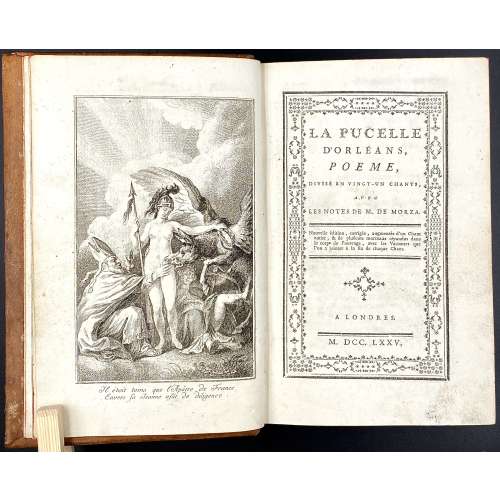 Half title: LA PUCELLE | D’ORLEANS.|| Title: LA PUCELLE | D’ORLEANS , | POEME , | DIVISÉ EN VINGT-UN CHANTS , AVEC | LES NOTES DE M. DE MORZA. | Nouvelle édition, corrigée, augmentée d'un Chant | entier, & de plusieurs morceaux répandus dans | le corps de l'ouvrage, avec les Variantes que | l'on a jointes à la fin de chaque Chant. | [ornament] | A LONDRES. |—| M. DCC. LXXV. || Pagination : [4] – two blank unnumbered fly leaves, [i,ii] – h.t. / double-ruled blank leaf, [2] – blank / frontispiece on verso, [iii, iv] – t.p. ruled and bordered / double-ruled blank leaf, [v]vi-viii – table, ix-xv – preface, [xvi] – double-ruled blank leaf, [1]2-447 [448] – double-ruled blank leaf, [2] – two blank unnumbered fly leaves; page 14 misnumbered 18; title within ornamental border; text within double-ruled borders; head- and tail-pieces; 22 leaves of plates (frontis. + one before each chant.) Collation: 8vo; a8 A-Z8 Aa-Ee8 Binding: 19.9 x 13.2 cm; full contemporary brown calf, blind ruled plates, spine with raised bands, gilt-ruled and tooled in compartments, red label with gilt lettering, all edges red; plate for chant 6, H4, H5 - separated from the block. De Morza is Voltaire (Cf. Quérard, v. 10, p. 306). Engravings unsigned; attributed to Desrais, Claude-Louis (French, 1746 – 1816). False imprint; possibly printed in Paris.
Half title: LA PUCELLE | D’ORLEANS.|| Title: LA PUCELLE | D’ORLEANS , | POEME , | DIVISÉ EN VINGT-UN CHANTS , AVEC | LES NOTES DE M. DE MORZA. | Nouvelle édition, corrigée, augmentée d'un Chant | entier, & de plusieurs morceaux répandus dans | le corps de l'ouvrage, avec les Variantes que | l'on a jointes à la fin de chaque Chant. | [ornament] | A LONDRES. |—| M. DCC. LXXV. || Pagination : [4] – two blank unnumbered fly leaves, [i,ii] – h.t. / double-ruled blank leaf, [2] – blank / frontispiece on verso, [iii, iv] – t.p. ruled and bordered / double-ruled blank leaf, [v]vi-viii – table, ix-xv – preface, [xvi] – double-ruled blank leaf, [1]2-447 [448] – double-ruled blank leaf, [2] – two blank unnumbered fly leaves; page 14 misnumbered 18; title within ornamental border; text within double-ruled borders; head- and tail-pieces; 22 leaves of plates (frontis. + one before each chant.) Collation: 8vo; a8 A-Z8 Aa-Ee8 Binding: 19.9 x 13.2 cm; full contemporary brown calf, blind ruled plates, spine with raised bands, gilt-ruled and tooled in compartments, red label with gilt lettering, all edges red; plate for chant 6, H4, H5 - separated from the block. De Morza is Voltaire (Cf. Quérard, v. 10, p. 306). Engravings unsigned; attributed to Desrais, Claude-Louis (French, 1746 – 1816). False imprint; possibly printed in Paris. -
![Jules Verne. Michael Strogoff : The courier of the Czar. (The story of the film). — London: The Readers Library Publishing Company Ltd., [1927]. — pp.: [1-13] 14-251 [252: printer's imprint] [253-256: blank], note: [note: first and last leaves used as front and rear paste-downs].](https://varshavskycollection.com/wp-content/uploads/2021/02/LIB-2460.2020-a-1-500x500.jpeg) First MGM edition, original maroon cloth, front and spine panels stamped in gold with decorations and lettering, partially darkened, wrap-around dust-jacket, chipped and torn near the head of spine with some loss, small chip and larger closed tear to lower panel. Photoplay edition. Film tie in edition for the 1926 French silent film which does not exist at this time in a full version. The front and rear panels depict scenes from the film. Bleiler (1978), p. 161. Not in Reginald (1979; 1992). Pagination: [2] – blank / advert., [2] – t.p. / coloph., [4] –advert. / editor's note, [2] – advert. / blank, [13] 14-251 [252: printer's imprint] [2] – blanks, note: [first and last leaves used as front and rear paste-downs]. Dimensions: 17 x 10.7 cm. Publisher: The Readers Library Publishing Company Ltd. (London). Publishing Year: 1927 (not indicated). Description of Shapero Rare Books, London: An attractive copy from this popular series of film editions, notable for their use of actors and scenes from the film version in question on the wrap-around dust-jacket, and sometimes photographic plates. A number of the film-makers involved were exiles from the Russian Revolution of 1917. The film's art direction was by Eduardo Gosch (Russian, American, 1890 – ?), César Lacca, Alexandre Lochakoff (Russian, French, fl. 1918–1939), Vladimir Meingard and Pierre Schild [Lakka Schildknecht] (Russian, Spanish, 1897 – 1968) who recreated the atmosphere of mid-nineteenth century Tsarist Russia. “Jules Verne has written no better book than this, in fact, it is deservedly ranked as one of the most thrilling tales ever written." Leonard S. Davidow, Classic Romances of Literature, 1937.
First MGM edition, original maroon cloth, front and spine panels stamped in gold with decorations and lettering, partially darkened, wrap-around dust-jacket, chipped and torn near the head of spine with some loss, small chip and larger closed tear to lower panel. Photoplay edition. Film tie in edition for the 1926 French silent film which does not exist at this time in a full version. The front and rear panels depict scenes from the film. Bleiler (1978), p. 161. Not in Reginald (1979; 1992). Pagination: [2] – blank / advert., [2] – t.p. / coloph., [4] –advert. / editor's note, [2] – advert. / blank, [13] 14-251 [252: printer's imprint] [2] – blanks, note: [first and last leaves used as front and rear paste-downs]. Dimensions: 17 x 10.7 cm. Publisher: The Readers Library Publishing Company Ltd. (London). Publishing Year: 1927 (not indicated). Description of Shapero Rare Books, London: An attractive copy from this popular series of film editions, notable for their use of actors and scenes from the film version in question on the wrap-around dust-jacket, and sometimes photographic plates. A number of the film-makers involved were exiles from the Russian Revolution of 1917. The film's art direction was by Eduardo Gosch (Russian, American, 1890 – ?), César Lacca, Alexandre Lochakoff (Russian, French, fl. 1918–1939), Vladimir Meingard and Pierre Schild [Lakka Schildknecht] (Russian, Spanish, 1897 – 1968) who recreated the atmosphere of mid-nineteenth century Tsarist Russia. “Jules Verne has written no better book than this, in fact, it is deservedly ranked as one of the most thrilling tales ever written." Leonard S. Davidow, Classic Romances of Literature, 1937. -
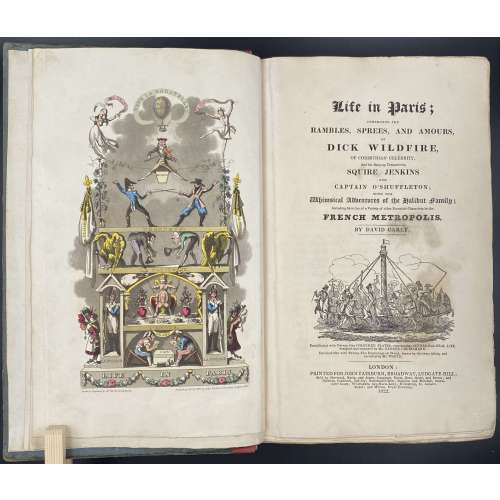
Title: Life in Paris ; | COMPRISING THE | RAMBLES, SPREES, AND AMOURS, | OF | DICK WILDFIRE, | OF CORINTHIAN CELEBRITY, | And his Bang-up Companions, SQUARE JENKINS | AND | CAPTAIN O’SHUFFLETON ; | WITH THE | Whimsical Adventures of the Halibut family ; | Including Sketches of a Variety of other Eccentric Characters in the | FRENCH METROPOLIS. | BY DAVID CAREY |[Vignette]| Embellished with Twenty-One COLOURED PLATES, representing SCENES from REAL LIFE, | designed and engraved by Mr. GEORGE CRUIKSHANK. | Enriched also with Twenty-Two Engravings on Wood, drawn by the same Artist, and | executed by Mr. WHITE. | LONDON : | PRINTED FOR JOHN FAIRBURN, BROADWAY, LUDGATE HILL; | Sold by Sherwood, Neely, and Jones ; Langman, Hurst, Rees, Orme, and Brown ; and | Baldwin, Craddoc, and Joy ; Paternoster-Row ; Simpkin and Marshall, Statio- | ners’ Court ; Whittakers Ave-Maria-Lane ; Humphrey, St. James’s | Street ; and Wilson, Royal Exchange. | 1822. ||
Edition: 1st edition in book form, 1st issue; large-paper copy bound from the parts in original blue paper boards, "most scarce" (Cohn).
Pagination: ffl, [i, ii] – h.t. ‘LIFE IN PARIS’ / ‘MARCHANT, Printer, Ingram-Court, London’, [2] – blank / Frontispiece (Ville la Bagatelle!!) hand-coloured, [iii, iv] – t.p. with vignette / blank, [v] vi-xxiv, [1] 2-489 [490 blank], [2] – 'TO THE BINDER' and 'Marchant, Printer, Ingram-Court, Fenchurch Street' "considered indispensable to a complete copy" (Cohn) / blank, bfl watermarked 1800; 21 hand-coloured aquatints and 22 wood-engraved text vignettes; cancelled leaves 143/4 and 335/6; pinholes from printing visible in most gatherings.
Collation: 4to; [a]-c4, B-Z4 Aa-Zz4 3A-3Q4 3R1 + [Ω]1
Binding: Original boards sometime re-backed with red paper, binder's end leaf watermarked 1800; red hard-grained morocco clamshell box.
Catalogue raisonné: Albert M. Cohn, 1924: № 109 p. 37/8; Abbey, J. R. (Life in England), 112; Tooley (Some English Books with Coloured Plates) 129; Hardie (English coloured books) 199.
Description of Shapero Rare Books, London: Of the copies that have come to auction since 1975 only one has been a large-paper copy in original boards. "The pictures are extremely spirited and true and are all the more wonderful in view of the fact that the artist’s continental experiences were limited to one day spent in Boulogne." (Hardie). In 1821, the journalist Pierce Egan published Life in London, an immediate success illustrated by the Cruikshank brothers, George and Robert. In order to capitalise on this success, another journalist, David Carey, decided to publish his own Life in Paris in monthly instalments (just like Life in London) and with a very similar frontispiece to the one that appears in Egan’s work; Life in Paris, however, was illustrated only by George Cruikshank. One of the earliest and most notable examples of the work of George Cruikshank, with fine, clean plates. -
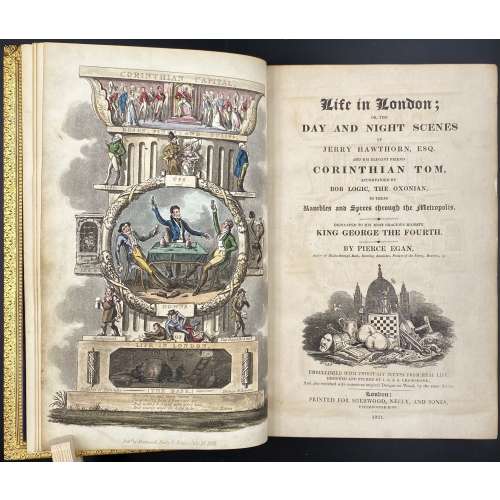
Title: Life in London ; | DAY AND NIGHT SCENES | OF | JERRY HAWTHORN, ESQ. | AND HIS ELEGANT FRIEND | CORINTHIAN TOM, | ACCOMPANIED BY | BOB LOGIC, THE OXONIAN, | IN THEIR |Rambles and Sprees through the Metropolis. | DEDICATED TO HIS MOST GRACIOUS MAJESTY | KING GEORGE THE FOURTH. | BY PIERCE EGAN, | Author of Walks through Bath, Sporting Anecdotes, Picture of the Fancy, Boxiana, &c. | [Vignette] | EMBELLISHED WITH THIRTY-SIX SCENES FROM REAL LIFE, | DESIGNED AND ETCHED BY I. R. & G. CRUIKSHANK ; | And also enriched with numerous original Designs on Wood, by the same Artists, | London: | PRINTED FOR SHERWOOD, NEELY, AND JONES, | PATERNOSTER-ROW. | 1821. ||
Edition: 1st edition, 1st issue: the first sheet of music is not numbered, absence of any footnote at page 9 (as per Cohn).
Pagination: 3 binder's flyleaves with a specimen of George Cruikshank's signature of Nov. 5th, 1860 to the first one; hand-coloured aquatint frontispiece facing the title page with blank recto, [iii-iv] – t.p. with vignette/ blank, [v] vi-viii – dedication, ix-xii – contents, [xiii]-xvi – list of illustrations; [1] 2-376; 35 hand-coloured aquatints, 3 folding leaves of music; bound without half-title [missing pp. i, ii], advertisements or 'to the subscribers' leaf.
Collation: 8vo; [A]7 B-Z8 Aa8-Bb4.
Binding: Full polished calf gilt by Rivière & Son, covers with triple gilt border, spine in 6 compartments, brown morocco lettering pieces to second and third, others richly gilt, raised bands, all edges gilt; neatly re-backed preserving spine.
Catalogue raisonné: Albert M. Cohn, 1924: № 262 p. 90; Abbey, J. R. (Life in England), 281; Tooley (Some English Books with Coloured Plates) 196; Prideaux (Aquatint Engraving) pp. 307, 310; Hardie (English coloured books) 197.
Description of Shapero Rare Books, London: There was a translation into French. At least six plays were based on Egan's characters, contributing to yet more sales. One of these was exported to America, launching the Tom and Jerry craze there. The version created by William Thomas Moncrieff was praised as The Beggar's Opera of its day. Moncrieff's production of Tom and Jerry, or Life in London ran continuously at the Adelphi Theatre for two seasons and it was the dramatist's work as much as the author's that did so much to popularise the book's trademark use of fashionable slang. In 1821 Egan announced the publication of a regular journal: Life in London, appearing monthly at a shilling a time. It was to be illustrated by George Cruikshank (1792 – 1878), and was dedicated to the King, George IV, who at one time had received Egan at court. The first edition of Life in London appeared on 15 July 1821. Egan's creation was an instant success. Pirate versions appeared, featuring such figures as 'Bob Tallyho', 'Dick Wildfire' and the like. Printmakers speedily knocked off cuts featuring the various 'stars' and the real-life public flocked to the 'sporting' addresses that Egan had his heroes frequent. -
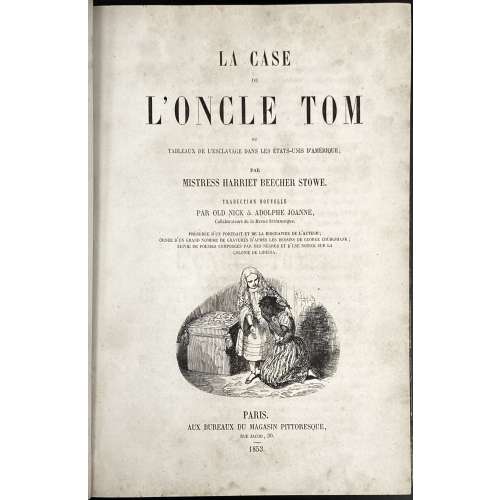 1st French edition (Paris, 1853) of Harriet Beecher Stowe's book Uncle Tom's Cabin; or, Life Among the Lowly, with 27 illustrations on wood by George Cruikshank (British, 1792 – 1878), translated into French by Paul-Émile Daurand-Forgues [pseudonym Old Nick] (French, 1813 – 1883) and Adolphe Joanne (French, 1813 – 1881). Title: LA CASE | DE | L'ONCLE TOM | OU | TABLE AUX DE L'ESCLAVAGE DANS LES ÉTATS-UNIS D'AMÉRIQUE ; | PAR MISTRESS HARRIET BEECHER STOWE. | TRADUCTION NOUVELLE | PAR OLD NICK & ADOLPHE JOANNE, | Collaboarteurs de la Revue britannique, | PRÉCÉDÉE D'UN PORTRAIT ET DE LA BIOGRAPHIE DE L'AUTEUR; | ORNÉE D'IU GRAND NOMBRE DE GRAVURES D'APRES LES DESSINS DE GEORGE CRUIKSHANK ; | SUIVIE DE POÉSIES COMPOSÉES PAR DES NÈGRES ET D'UNE NOTICE SUR LA | COLONIE DE LIBERIA. | [vignette] | PARIS. | AUX BUREAUX DU MAGASIN PITTORESQUE, | RUE JACOB, 30. | 1853. Pagination: ffl blank; [i-ii]: h.t. with stamped letters D. W. in the upper centre / imprim. to verso; [iii-iv] t.p. / blank; [v-vi] blank / frontispiece: portrait of Harriet Beecher Stowe, half-length to left, with hair in ringlets, and a shawl over shoulders, landscape behind, Henry Linton (British, 1815 – 1899) after Henry Anelay (British,1817 – 1883), wood-engraving with letterpress; [vij] Viij-xij; [1] 2-563 [564]; bfl blank; illustrations: 27 woodcuts by George Cruikshank. Collation: 8vo, π7 (1)–(35)8 363 Binding: Quarter brown calf, spine with raised bands, gilt-ruled compartments, title lettering, "D. W." in the bottom, marbled boards and endpapers. Dimensions: 24.1 x 16.4 cm. Catalogue raisonné: Albert M. Cohen (1924), №777, p. 221. "An edition was published in French with the woodcuts direct from the blocks, not, as in the English, merely from the stereotypes. The illustrations are far more impressive than those of Cassell's edition".
1st French edition (Paris, 1853) of Harriet Beecher Stowe's book Uncle Tom's Cabin; or, Life Among the Lowly, with 27 illustrations on wood by George Cruikshank (British, 1792 – 1878), translated into French by Paul-Émile Daurand-Forgues [pseudonym Old Nick] (French, 1813 – 1883) and Adolphe Joanne (French, 1813 – 1881). Title: LA CASE | DE | L'ONCLE TOM | OU | TABLE AUX DE L'ESCLAVAGE DANS LES ÉTATS-UNIS D'AMÉRIQUE ; | PAR MISTRESS HARRIET BEECHER STOWE. | TRADUCTION NOUVELLE | PAR OLD NICK & ADOLPHE JOANNE, | Collaboarteurs de la Revue britannique, | PRÉCÉDÉE D'UN PORTRAIT ET DE LA BIOGRAPHIE DE L'AUTEUR; | ORNÉE D'IU GRAND NOMBRE DE GRAVURES D'APRES LES DESSINS DE GEORGE CRUIKSHANK ; | SUIVIE DE POÉSIES COMPOSÉES PAR DES NÈGRES ET D'UNE NOTICE SUR LA | COLONIE DE LIBERIA. | [vignette] | PARIS. | AUX BUREAUX DU MAGASIN PITTORESQUE, | RUE JACOB, 30. | 1853. Pagination: ffl blank; [i-ii]: h.t. with stamped letters D. W. in the upper centre / imprim. to verso; [iii-iv] t.p. / blank; [v-vi] blank / frontispiece: portrait of Harriet Beecher Stowe, half-length to left, with hair in ringlets, and a shawl over shoulders, landscape behind, Henry Linton (British, 1815 – 1899) after Henry Anelay (British,1817 – 1883), wood-engraving with letterpress; [vij] Viij-xij; [1] 2-563 [564]; bfl blank; illustrations: 27 woodcuts by George Cruikshank. Collation: 8vo, π7 (1)–(35)8 363 Binding: Quarter brown calf, spine with raised bands, gilt-ruled compartments, title lettering, "D. W." in the bottom, marbled boards and endpapers. Dimensions: 24.1 x 16.4 cm. Catalogue raisonné: Albert M. Cohen (1924), №777, p. 221. "An edition was published in French with the woodcuts direct from the blocks, not, as in the English, merely from the stereotypes. The illustrations are far more impressive than those of Cassell's edition". -
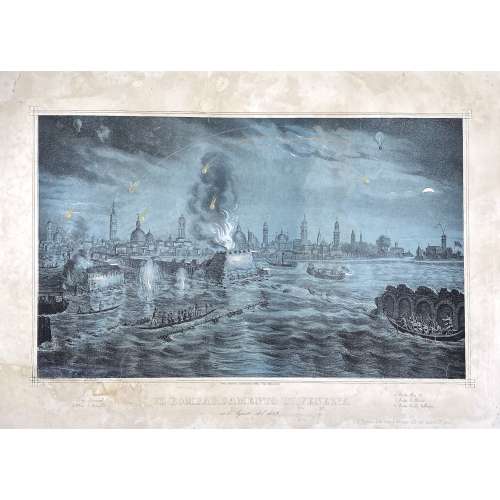 Quaritch's description: Single sheet (435 x 625 mm); coloured lithograph by Kirchmayr after a drawing by M. Fontana; hand-painted details; signed to lower left ‘M. Fon[tana]’ and to lower right ‘M. Fontana Edit. Prop. S. Giacomo dall’Orio in Isola N°.1481’; lower margin with the title ‘Il bombardamento di Venezia nell’Agosto 1849’ and key; restored tears in many places, especially along upper and lower blank margins, some affecting print; losses to lower left corner, affecting a small portion of the print, ruled border, and key, restored and re-drawn where needed; loss to the upper left corner of blank margin; two small areas of restoration to the centre of upper blank margin; the whole sheet backed; nevertheless a remarkable survival. Exceedingly rare and striking lithograph of Venice as seen from Fusina, depicting the first ever aerial bombardment in history. The bombardment took place in 1849, under the orders of Field Marshal Josef Radetzky (1766–1858), to quell the revolts that had started the previous year during the First Italian War of Independence. This curious and little-known action was the brainchild of Colonel Benno Uchatius, a brilliant young officer in the Austro-Hungarian Artillery. After long months of unsuccessful siege, Uchatius decided to deploy an unusual weapon: a hot air balloon able to bomb the city from above. Having calculated the wind speed and direction and evaluated the requisite dimensions of the hot-air balloon, Uchatius set up a workshop near Mestre, where a group of engineers and craftsmen began to manufacture a balloon equipped with a large wicker basket which could transport two crewmen and approximately one hundred kilograms of small long-fuse devices (metal spheres filled with gunpowder, pitch, oil and five hundred rifle buckshot). The initial trials, however, proved to be a disaster, because the balloon would drift off course, making it impossible to accurately deploy the bombs. Uchatius then hit upon the idea of using several smaller unmanned balloons roped together. These were to be launched over the city and, using the position of the first ‘pilot’ balloon, which was unarmed, the Austrians could calculate the correct fuse settings for the bombs. The ‘bomber’ balloons had a cloth envelope of one hundred cubic metres and a reduced load of about twenty kilograms of ordnance. According to Uchatius’ calculations, the line of balloons, launched from Mestre, would reach the lagoon city in thirty-five to forty minutes, carried by the north-west wind. In July 1849, a first launch was attempted, but when a breeze began to blow from the sea some of the balloons broke the connecting ropes and floated away, while others settled in the water in front of the northern part of the city, where a curious crowd of Venetians observed the failure of the enterprise and commented colourfully on the ‘buffoonery of Radetzky’. Uchatius’ second attempt, which is depicted in this lithograph, was also largely unsuccessful: only a few of the unmanned bomber balloons reached their target, and some even drifted back over the Austrian lines. Uchatius, having accomplished the first ever aerial bombardment, and having designed the first ever military ‘drones’, was forced to abandon the project permanently. Another fascinating aspect of this work is the vantage point used to depict the city of Venice, seen here from Fusina, a very rare viewpoint that makes this piece even more remarkable. We were unable to locate any copies in any institution or bibliography. G. Kirchmayr (fl. mid-19th century) is mentioned at British Museum database as "Lithographer active in Venice; related to Venetian painter Cherubino Kirchmayr (b. 1848)?" However, I was not able to find that name on the print. Not much is known of M. Fontana either.
Quaritch's description: Single sheet (435 x 625 mm); coloured lithograph by Kirchmayr after a drawing by M. Fontana; hand-painted details; signed to lower left ‘M. Fon[tana]’ and to lower right ‘M. Fontana Edit. Prop. S. Giacomo dall’Orio in Isola N°.1481’; lower margin with the title ‘Il bombardamento di Venezia nell’Agosto 1849’ and key; restored tears in many places, especially along upper and lower blank margins, some affecting print; losses to lower left corner, affecting a small portion of the print, ruled border, and key, restored and re-drawn where needed; loss to the upper left corner of blank margin; two small areas of restoration to the centre of upper blank margin; the whole sheet backed; nevertheless a remarkable survival. Exceedingly rare and striking lithograph of Venice as seen from Fusina, depicting the first ever aerial bombardment in history. The bombardment took place in 1849, under the orders of Field Marshal Josef Radetzky (1766–1858), to quell the revolts that had started the previous year during the First Italian War of Independence. This curious and little-known action was the brainchild of Colonel Benno Uchatius, a brilliant young officer in the Austro-Hungarian Artillery. After long months of unsuccessful siege, Uchatius decided to deploy an unusual weapon: a hot air balloon able to bomb the city from above. Having calculated the wind speed and direction and evaluated the requisite dimensions of the hot-air balloon, Uchatius set up a workshop near Mestre, where a group of engineers and craftsmen began to manufacture a balloon equipped with a large wicker basket which could transport two crewmen and approximately one hundred kilograms of small long-fuse devices (metal spheres filled with gunpowder, pitch, oil and five hundred rifle buckshot). The initial trials, however, proved to be a disaster, because the balloon would drift off course, making it impossible to accurately deploy the bombs. Uchatius then hit upon the idea of using several smaller unmanned balloons roped together. These were to be launched over the city and, using the position of the first ‘pilot’ balloon, which was unarmed, the Austrians could calculate the correct fuse settings for the bombs. The ‘bomber’ balloons had a cloth envelope of one hundred cubic metres and a reduced load of about twenty kilograms of ordnance. According to Uchatius’ calculations, the line of balloons, launched from Mestre, would reach the lagoon city in thirty-five to forty minutes, carried by the north-west wind. In July 1849, a first launch was attempted, but when a breeze began to blow from the sea some of the balloons broke the connecting ropes and floated away, while others settled in the water in front of the northern part of the city, where a curious crowd of Venetians observed the failure of the enterprise and commented colourfully on the ‘buffoonery of Radetzky’. Uchatius’ second attempt, which is depicted in this lithograph, was also largely unsuccessful: only a few of the unmanned bomber balloons reached their target, and some even drifted back over the Austrian lines. Uchatius, having accomplished the first ever aerial bombardment, and having designed the first ever military ‘drones’, was forced to abandon the project permanently. Another fascinating aspect of this work is the vantage point used to depict the city of Venice, seen here from Fusina, a very rare viewpoint that makes this piece even more remarkable. We were unable to locate any copies in any institution or bibliography. G. Kirchmayr (fl. mid-19th century) is mentioned at British Museum database as "Lithographer active in Venice; related to Venetian painter Cherubino Kirchmayr (b. 1848)?" However, I was not able to find that name on the print. Not much is known of M. Fontana either. -
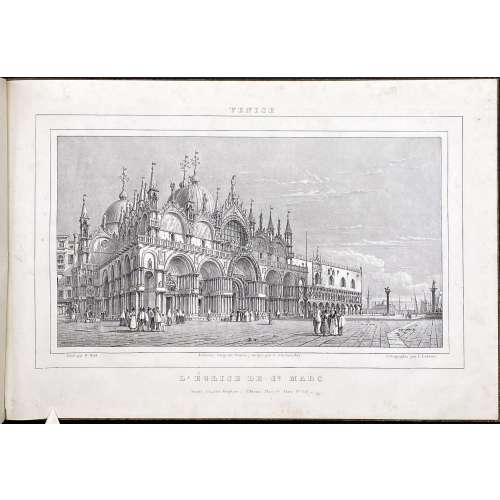 Owner's convolute binding of the period in quarter tan cloth, yellow marbled boards, no title page, no pagination. Contents: (1) Venetian Album –12 lithographs by Émile-Aubert Lessore (French, 1805 – 1876) after William Wyld (British, 1806 – 1889). — Venice: Charles Hopfner, [1834]. Printed at Premiata Litografia Veneta under the direction of Ferdinand Wolfgang Flachenecker (German, 1782 – 1847). Inscription: Premiata Litografia Veneta, dirigée par C. Flachenecker.
Owner's convolute binding of the period in quarter tan cloth, yellow marbled boards, no title page, no pagination. Contents: (1) Venetian Album –12 lithographs by Émile-Aubert Lessore (French, 1805 – 1876) after William Wyld (British, 1806 – 1889). — Venice: Charles Hopfner, [1834]. Printed at Premiata Litografia Veneta under the direction of Ferdinand Wolfgang Flachenecker (German, 1782 – 1847). Inscription: Premiata Litografia Veneta, dirigée par C. Flachenecker.- L'Église de St. Marc
- La place St. Marc
- Le palais Ducal
- Le Môle
- L'Arsenal
- La Riva dei Schiavoni
- Le Grand Canal, (1re vue)
- Le Grand Canal (2me vue)
- Le Grand Canal (3me vue)
- Le Grand Canal (4me vue)
- Le Grand Canal (5me vue)
- Le Grand Canal (6me vue)
- Title: Spiegazione / delli quattro prospetti dei bassi rilievi in marmo che circondano le mura della S. Casa di Loreto / qui annessi in puntata, oltre l'altro prospetto del palazzo pontificio / facciata del tempio, campanile, e cuppola etc.
- Prospetto della Basilica, e Piazza Lauretana, ed annesso Palazzo Apostolico / V. Jaffei incise.
- Settentrione. Prospetto laterale de Bassirilievi in Marmo, che circondano le Mura di S. Casa di Loreto. Jaffei incise Loreto.
- Oriente. Prospetto de Bassirilievi in Marmo, che circ=ondano le Mura di S. Casa. Jaffei incise Loreto l'Anno 1828.
- Mezzo Giorno. Prospetto laterale de Bassirilievi in Marmo, che circondano le Mura di S. Casa di Loreto. Jaffei dis. ed inc. in Loreto.
- Occidente. Prospetto de Bassirilievi in Marmo, che circ=ondano le Mura di S. Casa. Jaffei dis. ed inc. in Loreto l'Anno 1828.
-
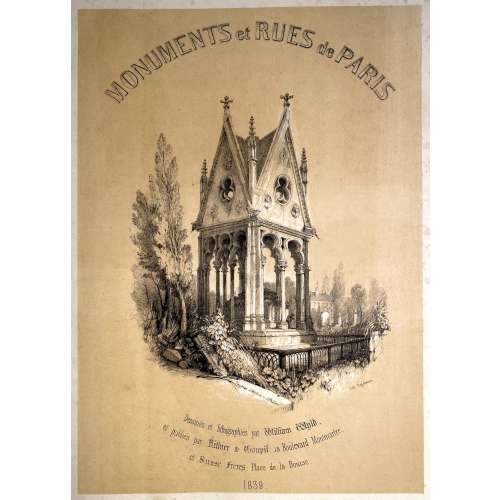 Pictorial album 55.5 x 41.0 cm, publisher’s quarter sheepskin over cloth, upper cover and flat spine lettered in gilt. Title: MONUMENTS et RUES de PARIS | Dessinés et lithographiés par William Wyld, | et publiés par Rittner & Goupil, 15 Boulevard Montmartre, | et Susse Frères, Place de la Bourse. | 1839. Collation: Title plate + 20 plates numbered from 1 to 20, printed by Godefroy Engelmann (French, 1788 – 1839) in tone lithography after drawings by William Wyld (British, 1806 – 1889). Published in Paris by Rittner & Goupil and Susse Frères in 1839. Plates: 54.8 x 39.8 cm. Contents:
Pictorial album 55.5 x 41.0 cm, publisher’s quarter sheepskin over cloth, upper cover and flat spine lettered in gilt. Title: MONUMENTS et RUES de PARIS | Dessinés et lithographiés par William Wyld, | et publiés par Rittner & Goupil, 15 Boulevard Montmartre, | et Susse Frères, Place de la Bourse. | 1839. Collation: Title plate + 20 plates numbered from 1 to 20, printed by Godefroy Engelmann (French, 1788 – 1839) in tone lithography after drawings by William Wyld (British, 1806 – 1889). Published in Paris by Rittner & Goupil and Susse Frères in 1839. Plates: 54.8 x 39.8 cm. Contents:Title page: Tombeau d'Heloïse et d'Abélard
- Le Pont Neuf
- L'église de la Madeleine
- La Porte St. Martin
- Palais des Tuileries
- Pont des Saints-Pères
- Hôtel de Ville
- Marché des Innocents
- Palais Royal
- Boulevard des Italiens
- Rue de la Paix
- Bourse et Tribunal de Commerce
- Porte St. Denis
- Pont Royal
- Place de la Concorde
- Paris from Père Lachaise
- Notre-Dame
- Jardin des Tuileries with Arc de Triomphe in the Distance
- Panthéon
- Chambre des députés
- Arc de Triomphe de l'Étoile
-
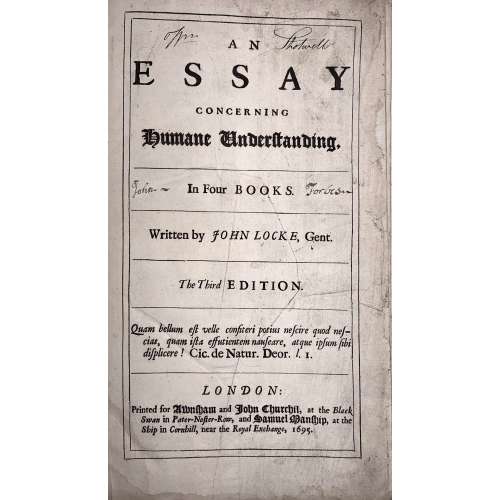 Title: AN | ESSAY | CONCERNING | HUMANE UNDERSTANDING, |—| In Four BOOKS. |—| Written by JOHN LOCKE, Gent. |—| The Third EDITION. |—| Quam bellum est velle confiteri potius nescire quod nes- | cias, quam ista effutientem nauseare, atque ipsum sibi | displicere! Cic. De Natur. Deor. l. I. |—| LONDON: | Printed for Awnsham and John Churchil, at the Black | Swan in Pater-Noster-Row, and Samuel Manship, at the | Ship in Cornhill, near the Royal Exchange, 1695. Collation: [π2]-b6, a-c4, B-Z4 Aa-Zz4 Aaa-Fff4 Ggg-Iii2 Pagination: [40] 1-407 [13]. Catalogue raisoné: The works of John Locke; a comprehensive bibliography from the seventeenth century to the present. Compiled by John C. Attig. Series: Bibliographies and Indexes in Philosophy, Number 1. Greenwood Press, Westport, CT & London, England, 1985. p. 42, №230 provides for pagination [40] 407, [13]p. Page by page reprint of 1694 edition. Regarding the epigraph on t.p.: The correct citation from , De Natura Deorum: "Quam bellum erat, Vellei, confiteri potius nescire, quod nescires, quam ista effutientem nauseare atque ipsum sibi displicere." [How delightful it would be, Velleius, if when you did not know a thing you would admit your ignorance, instead of uttering this drivel, which must make even your own gorge rise with disgust!] This life-time edition was presented as a gift to Dr Elisha Atkins (1949 – 2019), professor at Yale University School of Medicine, on July 1st, 1967, by his students, namely Carolyn Wells [Bush] (1923 – 2013), John Mooney (now a psychiatrist in Boston), and Charles Dinarello. Size: 32 x 23 cm Binding: Fill modern morocco, panelled and ruled gilt, raised bands, gilt in compartments, red label with gilt lettering; in a slipcase.
Title: AN | ESSAY | CONCERNING | HUMANE UNDERSTANDING, |—| In Four BOOKS. |—| Written by JOHN LOCKE, Gent. |—| The Third EDITION. |—| Quam bellum est velle confiteri potius nescire quod nes- | cias, quam ista effutientem nauseare, atque ipsum sibi | displicere! Cic. De Natur. Deor. l. I. |—| LONDON: | Printed for Awnsham and John Churchil, at the Black | Swan in Pater-Noster-Row, and Samuel Manship, at the | Ship in Cornhill, near the Royal Exchange, 1695. Collation: [π2]-b6, a-c4, B-Z4 Aa-Zz4 Aaa-Fff4 Ggg-Iii2 Pagination: [40] 1-407 [13]. Catalogue raisoné: The works of John Locke; a comprehensive bibliography from the seventeenth century to the present. Compiled by John C. Attig. Series: Bibliographies and Indexes in Philosophy, Number 1. Greenwood Press, Westport, CT & London, England, 1985. p. 42, №230 provides for pagination [40] 407, [13]p. Page by page reprint of 1694 edition. Regarding the epigraph on t.p.: The correct citation from , De Natura Deorum: "Quam bellum erat, Vellei, confiteri potius nescire, quod nescires, quam ista effutientem nauseare atque ipsum sibi displicere." [How delightful it would be, Velleius, if when you did not know a thing you would admit your ignorance, instead of uttering this drivel, which must make even your own gorge rise with disgust!] This life-time edition was presented as a gift to Dr Elisha Atkins (1949 – 2019), professor at Yale University School of Medicine, on July 1st, 1967, by his students, namely Carolyn Wells [Bush] (1923 – 2013), John Mooney (now a psychiatrist in Boston), and Charles Dinarello. Size: 32 x 23 cm Binding: Fill modern morocco, panelled and ruled gilt, raised bands, gilt in compartments, red label with gilt lettering; in a slipcase. -
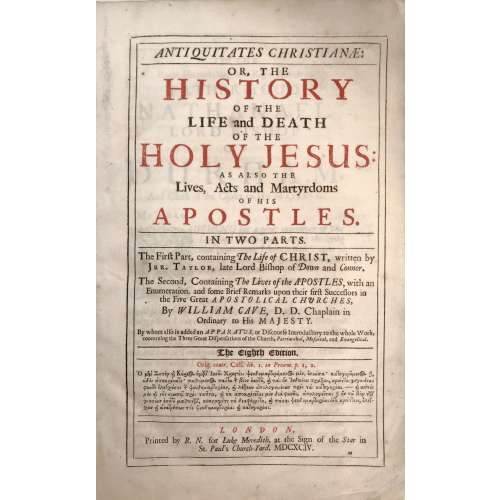 Title (black and red): ANTIQUITATES CHRISTIANÆ: |—| OR, THE | HISTORY | OF THE | LIFE AND DEATH | OF THE | HOLY JESUS: | AS ALSO THE Lives, Acts and Martyrdoms | OF HIS | APOSTLES. |—| IN TWO PARTS. |—| The Firƒt Part, containing The Life of CHRIST, written by | Jer. Taylor, Late Lord Bishop of Down and Connor. | The Second, Containing The Lives of the APOSTLES, with an | Enumeration, and ƒome Brief Remarks upon their firƒt Successors in | the Five Great APOSTOLICAL CHURCHES, | By WILLIAM CAVE, D. D. Chaplain in | Ordinary to His MAJESTY. | By whom alƒo is added an APPARATUS, or Diƒcourƒe Introductory to the whole Work, | concerning the Three Great Diƒpenƒations of the Church, Patriarchal, Moƒaical, and Evangelical. |—| THE EIGHTH EDITION. |—| Orig. contr. Celƒ. lib. 1. in Proœm. p. 1, 2. | [text in Greek] |—| LONDON, | Printed by R. N. for Luke Meredith, at the Sign of the Star in | St. Paul's Church-Yard, MDCXCIV. Collation of this book is unusual, it is called "Folio in 6s" (three sheets are folded in half to create a gathering of 6 leaves). Two unsigned leaves: (1) Engraved frontispiece "The Annunciation" by Willian Faithorne "the Elder" (British, 1616 – 1691), recto blank; (2) engraved title by the same engraver, verso blank; (*) gathering of 4: black and red title page, verso blank; epistle; to reader; imprim. (A6 to Sƒ6) Engraved portrait of Jeremy Taylor by Pierre Lombart (French, 1612 – 1682); faux title page: "The Great Exemplar of Sanctity and Holy Life... MDCXCIII"; dedication; contents, then to the end of the first book. (A-Z4 Aa-Bb4 Cc2) The second book has collation in quarto: Faux title page: "Antiquitates Christianæ: or the Lives, Acts and Martyrdoms... MDCXCIV", etc. to the end. Full formula: π2 *4 a-c6 d8 A-Z6 Aa-Sƒ6 A-Z4 Aa-Bb4 Cc2 Pagination: [12] I-LI [LII] [12] I-XXVIII, i-vi, (1st book): [2] I-145 [146-150] 151-432 [12]; (2nd book): [8] i-xiv, 1-188. 22 plates : frontis., t.p., portrait, one folding before p. 65, two after pp. [146], [150], 282, 304, 364, 386, 414, [422], and numerous head-pieces. Size: 36 x 23.5 x 5.7 cm Binding: full calf with the later spine, raised bands; front board with remnants of gilt ruling and blind stamped border, back bord probably original with a blind-stamped centre panel with fleurons.
Title (black and red): ANTIQUITATES CHRISTIANÆ: |—| OR, THE | HISTORY | OF THE | LIFE AND DEATH | OF THE | HOLY JESUS: | AS ALSO THE Lives, Acts and Martyrdoms | OF HIS | APOSTLES. |—| IN TWO PARTS. |—| The Firƒt Part, containing The Life of CHRIST, written by | Jer. Taylor, Late Lord Bishop of Down and Connor. | The Second, Containing The Lives of the APOSTLES, with an | Enumeration, and ƒome Brief Remarks upon their firƒt Successors in | the Five Great APOSTOLICAL CHURCHES, | By WILLIAM CAVE, D. D. Chaplain in | Ordinary to His MAJESTY. | By whom alƒo is added an APPARATUS, or Diƒcourƒe Introductory to the whole Work, | concerning the Three Great Diƒpenƒations of the Church, Patriarchal, Moƒaical, and Evangelical. |—| THE EIGHTH EDITION. |—| Orig. contr. Celƒ. lib. 1. in Proœm. p. 1, 2. | [text in Greek] |—| LONDON, | Printed by R. N. for Luke Meredith, at the Sign of the Star in | St. Paul's Church-Yard, MDCXCIV. Collation of this book is unusual, it is called "Folio in 6s" (three sheets are folded in half to create a gathering of 6 leaves). Two unsigned leaves: (1) Engraved frontispiece "The Annunciation" by Willian Faithorne "the Elder" (British, 1616 – 1691), recto blank; (2) engraved title by the same engraver, verso blank; (*) gathering of 4: black and red title page, verso blank; epistle; to reader; imprim. (A6 to Sƒ6) Engraved portrait of Jeremy Taylor by Pierre Lombart (French, 1612 – 1682); faux title page: "The Great Exemplar of Sanctity and Holy Life... MDCXCIII"; dedication; contents, then to the end of the first book. (A-Z4 Aa-Bb4 Cc2) The second book has collation in quarto: Faux title page: "Antiquitates Christianæ: or the Lives, Acts and Martyrdoms... MDCXCIV", etc. to the end. Full formula: π2 *4 a-c6 d8 A-Z6 Aa-Sƒ6 A-Z4 Aa-Bb4 Cc2 Pagination: [12] I-LI [LII] [12] I-XXVIII, i-vi, (1st book): [2] I-145 [146-150] 151-432 [12]; (2nd book): [8] i-xiv, 1-188. 22 plates : frontis., t.p., portrait, one folding before p. 65, two after pp. [146], [150], 282, 304, 364, 386, 414, [422], and numerous head-pieces. Size: 36 x 23.5 x 5.7 cm Binding: full calf with the later spine, raised bands; front board with remnants of gilt ruling and blind stamped border, back bord probably original with a blind-stamped centre panel with fleurons. -
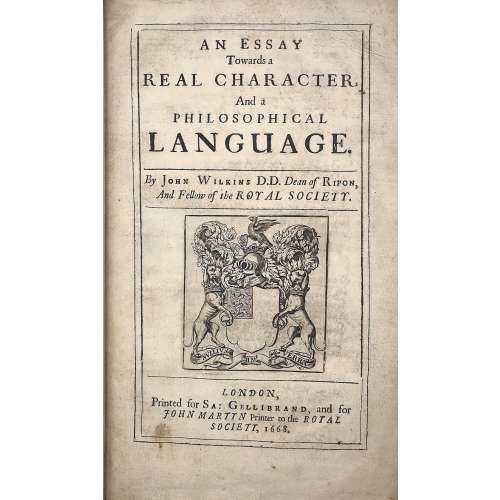 Title: AN ESSAY | Towards a | REAL CHARACTER, | And a | PHILOSOPHICAL | LANGUAGE. | By John Wilkins D.D. Dean of Ripon, | And Fellow of the ROYAL SOCIETY. |—| [armorial device] |—| LONDON, | Printed for Sa: Gellibrand, and for | JOHN MARTYN Printer to the ROYAL | SOCIETY, 1668. Pagination: [2] blank/order, [2] t.p./blank, [16], 1-454; + 79 leaves of Dictionary, unpaginated (158 pages); Illustrations: folding plates before pp. 167, 187, and two folding plates before p. 443. Collation: π2 a-d2 B-Z4 Aa-Zz4 Aaa-Lll4 Mmm3 aaa4 Aaa-Sss4 ttt3 Size: 4to, 32 x 20 x 5 cm; Binding: Full speckled calf, later polished calf spine with raised bands, double fillet ruled gilt compartments, crimson label with gilt lettering, margins sprinkled red. The work of John Wilkins is dedicated to the problem of the universal language. Wilkins was the Dean of Ripon from 1663 to 1672 and one of the founders of the Royal Society.
Title: AN ESSAY | Towards a | REAL CHARACTER, | And a | PHILOSOPHICAL | LANGUAGE. | By John Wilkins D.D. Dean of Ripon, | And Fellow of the ROYAL SOCIETY. |—| [armorial device] |—| LONDON, | Printed for Sa: Gellibrand, and for | JOHN MARTYN Printer to the ROYAL | SOCIETY, 1668. Pagination: [2] blank/order, [2] t.p./blank, [16], 1-454; + 79 leaves of Dictionary, unpaginated (158 pages); Illustrations: folding plates before pp. 167, 187, and two folding plates before p. 443. Collation: π2 a-d2 B-Z4 Aa-Zz4 Aaa-Lll4 Mmm3 aaa4 Aaa-Sss4 ttt3 Size: 4to, 32 x 20 x 5 cm; Binding: Full speckled calf, later polished calf spine with raised bands, double fillet ruled gilt compartments, crimson label with gilt lettering, margins sprinkled red. The work of John Wilkins is dedicated to the problem of the universal language. Wilkins was the Dean of Ripon from 1663 to 1672 and one of the founders of the Royal Society. -
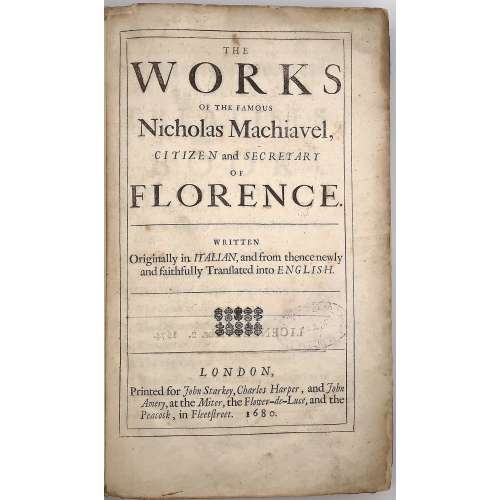 Title: THE | WORKS | OF THE FAMOUS | Nicholas Machiavel, | CITIZEN and SECRETARY | OF | FLORENCE. |—| WRITTEN | Originally in ITALIAN, and from thence newly | and faithfully Tranſlated into ENGLISH. |—|[ornament]|—| LONDON, | Printed for John Starkey, Charles Harper, and John | Amery, at the Miter, the Flower-de-Luce, and the | Peacock, in Fleetstreet. 1680. Content: (1) The history of Florence; (2) The Prince; (3) The Original of the Guelf and Ghibilin Factions; (4) The Life of Castruccio Castracani; (5) The Murther of Vitelli, etc. by Duke Valentino; (6) The State of France; (7) The State of Germany; (8) The Discourses on Titus Livius; (9) The Art of War; (10) The Marriage of Belphegor, a Novel; (11) Nicholas Machiavel's Letter in Vindication of Himself and His Writings. Pagination: ffl, 24 unnumbered pages before the first numbered: [2] – tp / license], [2] – contents / blank], [2] ftp “Florence” / blank, [3] – epistle to Clement VII, [3] – introduction, [12] – table; Misnumbering (X instead of Y format – X/Y): History of Florence: 1- 28/24, 19/91, 198/98, 180/108, 190/109, 174/164, 175/ 165, 179/169, 180/170, 185/175, 186/176, 188/178, 189/179, [190/180 blank]; The Prince, Lucca, State of France: [4] 199-262; State of Germany: 256/263, 266/264, 267/265 [268/266]; Discourses: [4] 267-314, 317-431 [432]; Art of War: [4] 433-528; [4] – publisher, [12] –Machiavelli’s letter, bfl. Collation: π3 Aa3 b-d2 B-Z4 Aa-Bb2 Cc-Zz4 Aaa-Yyy4 (*)-(**)4 Binding: Original mottled leather boards with embossing, later leather spine with 5 raised bands, crimson label with gilt lettering. Size: 32.4 x 21.0 x 4.0 cm Provenance: Bradford H. Gray This is the second edition; despite misnumbering, the collation is correct and all pages present. The first edition of this book was published in 1675 by Robert Bolter (British, fl. 1666 – 1683).
Title: THE | WORKS | OF THE FAMOUS | Nicholas Machiavel, | CITIZEN and SECRETARY | OF | FLORENCE. |—| WRITTEN | Originally in ITALIAN, and from thence newly | and faithfully Tranſlated into ENGLISH. |—|[ornament]|—| LONDON, | Printed for John Starkey, Charles Harper, and John | Amery, at the Miter, the Flower-de-Luce, and the | Peacock, in Fleetstreet. 1680. Content: (1) The history of Florence; (2) The Prince; (3) The Original of the Guelf and Ghibilin Factions; (4) The Life of Castruccio Castracani; (5) The Murther of Vitelli, etc. by Duke Valentino; (6) The State of France; (7) The State of Germany; (8) The Discourses on Titus Livius; (9) The Art of War; (10) The Marriage of Belphegor, a Novel; (11) Nicholas Machiavel's Letter in Vindication of Himself and His Writings. Pagination: ffl, 24 unnumbered pages before the first numbered: [2] – tp / license], [2] – contents / blank], [2] ftp “Florence” / blank, [3] – epistle to Clement VII, [3] – introduction, [12] – table; Misnumbering (X instead of Y format – X/Y): History of Florence: 1- 28/24, 19/91, 198/98, 180/108, 190/109, 174/164, 175/ 165, 179/169, 180/170, 185/175, 186/176, 188/178, 189/179, [190/180 blank]; The Prince, Lucca, State of France: [4] 199-262; State of Germany: 256/263, 266/264, 267/265 [268/266]; Discourses: [4] 267-314, 317-431 [432]; Art of War: [4] 433-528; [4] – publisher, [12] –Machiavelli’s letter, bfl. Collation: π3 Aa3 b-d2 B-Z4 Aa-Bb2 Cc-Zz4 Aaa-Yyy4 (*)-(**)4 Binding: Original mottled leather boards with embossing, later leather spine with 5 raised bands, crimson label with gilt lettering. Size: 32.4 x 21.0 x 4.0 cm Provenance: Bradford H. Gray This is the second edition; despite misnumbering, the collation is correct and all pages present. The first edition of this book was published in 1675 by Robert Bolter (British, fl. 1666 – 1683). -
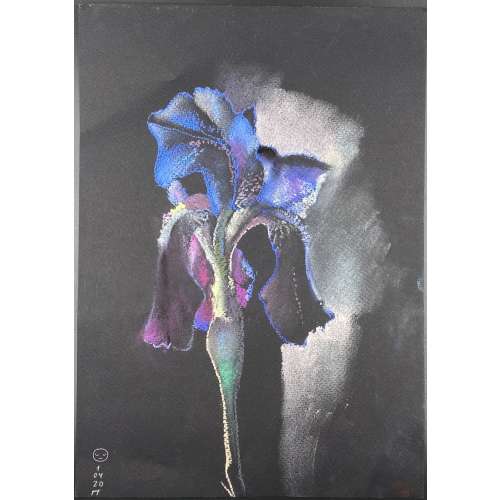 Polina de Mauny [Vladimirova] (Russian, French, b. 1981). Dry pastel on black paper. Size: 30 x 21 cm.
Polina de Mauny [Vladimirova] (Russian, French, b. 1981). Dry pastel on black paper. Size: 30 x 21 cm. -
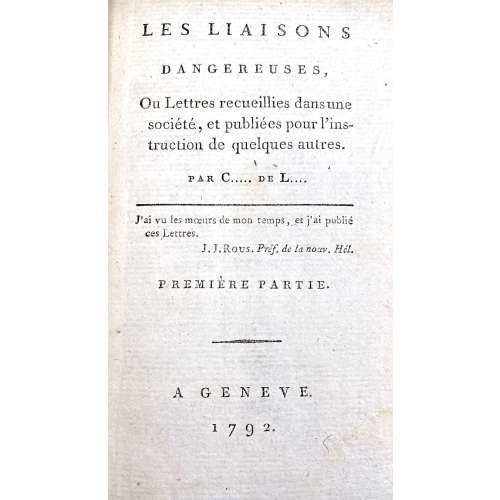 Four parts bound in two 18mo volumes (1-2 & 3-4), half polished brown calf, dot-ruled, flat spine with gilt bands and lettering, marbled boards, some plates with guard sheets, margins sparkled red. Title-page: LES LIAISONS | DANGEREUSES, | Ou Lettres recueillies dans une | société, et publiées pour l’ins- | truction de quelques autres. | par C….. de L… | — | J’ai vu les mœurs de mon temps, et j’ai publié | ces Lettres. | J. J. Rous. Préf. De la nouv. Hél. | PREMIÈRE PARTIE. | — | A GENEVE. | 1792. || Vol. 1: Pagination: ffep, blank, [2] – h.t., [i, ii] – t.p. part one, [iii] iv-xxij, [1] 2-245 [246] + 2 plates (p. 26 & p. 75); [1, 2] – h.t., [3, 4] – t.p. part two, [5] 6-233 [234], fep + 2 plates (p. 59 & p. 222). Collation: part 1: a12, A-M18 N5; part 2: A-M18 N9, plus four plates by various engravers after Le Barbier. Vol. 2: Pagination: ffep, blank, [1, 2] – h.t., [3, 4] – t.p. part three, [5] 6-225 [226] + 2 plates (p. 69 & p. 215); [1, 2] – h.t., [3, 4] – t.p. part four, [5] 6-250, fep + 2 plates (p. 25 & p. 201). Collation: part 3: A-M18 N5; part 4: A-N18 O5, plus four plates by various engravers after Le Barbier. Illustrations: After Le Barbier, engravers: Halbou (1), Simonet (1), N. Thomas (2), Dambrun (2), and Delignon (2). In the first illustration (vol. 1, part one, p. 26) Le Barbier signed “Le Barbier Jnv. 1794”, however, the edition was published (anonymously) in 1792. Cohen-De Ricci mentions an edition of 1794 (Paris: Maradan) and 1801 (Genéve) with the same plates. Lewine mentions a reprint of 1794 without naming the publisher. Catalogue raisonné: Cohen-De Ricci: 234-5, Ray: p. 79; Lewine: 109-10. Contributors: Choderlos de Laclos, Pierre Ambroise François (French, 1741 – 1803) – author. Le Barbier, Jean-Jacques-François (French, 1738 – 1826) – artist Engravers: Dambrun, Jean (French, 1741 – c. 1808) Delignon, Jean Louis (French, 1755 – 1804) Halbou, Louis Michel (1730 – 1809) Thomas, N. (French, c. 1750 – 1812) Simonet, Jean-Baptiste Blaise (French, 1742 – 1813)
Four parts bound in two 18mo volumes (1-2 & 3-4), half polished brown calf, dot-ruled, flat spine with gilt bands and lettering, marbled boards, some plates with guard sheets, margins sparkled red. Title-page: LES LIAISONS | DANGEREUSES, | Ou Lettres recueillies dans une | société, et publiées pour l’ins- | truction de quelques autres. | par C….. de L… | — | J’ai vu les mœurs de mon temps, et j’ai publié | ces Lettres. | J. J. Rous. Préf. De la nouv. Hél. | PREMIÈRE PARTIE. | — | A GENEVE. | 1792. || Vol. 1: Pagination: ffep, blank, [2] – h.t., [i, ii] – t.p. part one, [iii] iv-xxij, [1] 2-245 [246] + 2 plates (p. 26 & p. 75); [1, 2] – h.t., [3, 4] – t.p. part two, [5] 6-233 [234], fep + 2 plates (p. 59 & p. 222). Collation: part 1: a12, A-M18 N5; part 2: A-M18 N9, plus four plates by various engravers after Le Barbier. Vol. 2: Pagination: ffep, blank, [1, 2] – h.t., [3, 4] – t.p. part three, [5] 6-225 [226] + 2 plates (p. 69 & p. 215); [1, 2] – h.t., [3, 4] – t.p. part four, [5] 6-250, fep + 2 plates (p. 25 & p. 201). Collation: part 3: A-M18 N5; part 4: A-N18 O5, plus four plates by various engravers after Le Barbier. Illustrations: After Le Barbier, engravers: Halbou (1), Simonet (1), N. Thomas (2), Dambrun (2), and Delignon (2). In the first illustration (vol. 1, part one, p. 26) Le Barbier signed “Le Barbier Jnv. 1794”, however, the edition was published (anonymously) in 1792. Cohen-De Ricci mentions an edition of 1794 (Paris: Maradan) and 1801 (Genéve) with the same plates. Lewine mentions a reprint of 1794 without naming the publisher. Catalogue raisonné: Cohen-De Ricci: 234-5, Ray: p. 79; Lewine: 109-10. Contributors: Choderlos de Laclos, Pierre Ambroise François (French, 1741 – 1803) – author. Le Barbier, Jean-Jacques-François (French, 1738 – 1826) – artist Engravers: Dambrun, Jean (French, 1741 – c. 1808) Delignon, Jean Louis (French, 1755 – 1804) Halbou, Louis Michel (1730 – 1809) Thomas, N. (French, c. 1750 – 1812) Simonet, Jean-Baptiste Blaise (French, 1742 – 1813) -
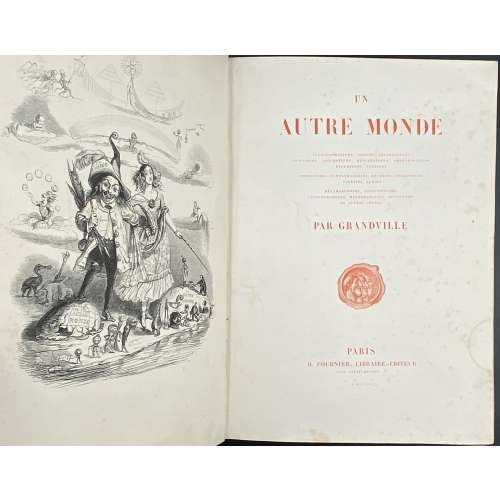 Description: One volume, collated 4t0, 27.3 x 20 cm, bound in contemporary quarter black chagrin, gilt ornaments and lettering to spine (reliure à l'époque romantique), marbled end-papers; printed on wove paper (vélin fort). Title-page (red): UN | AUTRE MONDE | TRANSFORMATIONS, VISIONS, INCARNATIONS | ASCENSIONS, LOCOMOTIONS, EXPLORATIONS, PÉRÉGRINATIONS | EXCURSIONS, STATIONS || COSMOGONIES, FANTASMAGORIES, RÈVERIES, FOLATRERIES | FACÉCIES, LUBIES || MÉTAMORPHOSES, ZOOMORPHOSES | LITHOMORPHOSES, MÉTEMPSYCHOSES, APOTHÉOSES | ET AUTRES CHOSES | PAR GRANDVILLE | [device] | PARIS | H. FOURNIER, LIBRAIRE-ÉDITEUR | RUE SAINT-BENOIT, 7 | M DCCC XLIV Pagination: ff, [2] half-title in red / imprim., [2] blank / frontis. in black, [2] title page in red / blank, [1] 2-295, [1] explication and erratum, bf, illustrations. Collation: 4to, (1)-(37)4 with frontispiece, 133 woodcut vignettes, 15 full-page black woodcuts, and 36 hand-coloured plates. Catalogue raisonné: Carteret (p. 285) describes the book as 'in-8', but the collation is actually in quarto (in-4, or 4to) with series signed in Arabic numerals. Ray (French): p. 275-7. The publication is anonymous, however, Grandville reveals the author's name (that's Taxile Delord) on the vignette on p. 292 at the bottom of the plate (under ICI).
Description: One volume, collated 4t0, 27.3 x 20 cm, bound in contemporary quarter black chagrin, gilt ornaments and lettering to spine (reliure à l'époque romantique), marbled end-papers; printed on wove paper (vélin fort). Title-page (red): UN | AUTRE MONDE | TRANSFORMATIONS, VISIONS, INCARNATIONS | ASCENSIONS, LOCOMOTIONS, EXPLORATIONS, PÉRÉGRINATIONS | EXCURSIONS, STATIONS || COSMOGONIES, FANTASMAGORIES, RÈVERIES, FOLATRERIES | FACÉCIES, LUBIES || MÉTAMORPHOSES, ZOOMORPHOSES | LITHOMORPHOSES, MÉTEMPSYCHOSES, APOTHÉOSES | ET AUTRES CHOSES | PAR GRANDVILLE | [device] | PARIS | H. FOURNIER, LIBRAIRE-ÉDITEUR | RUE SAINT-BENOIT, 7 | M DCCC XLIV Pagination: ff, [2] half-title in red / imprim., [2] blank / frontis. in black, [2] title page in red / blank, [1] 2-295, [1] explication and erratum, bf, illustrations. Collation: 4to, (1)-(37)4 with frontispiece, 133 woodcut vignettes, 15 full-page black woodcuts, and 36 hand-coloured plates. Catalogue raisonné: Carteret (p. 285) describes the book as 'in-8', but the collation is actually in quarto (in-4, or 4to) with series signed in Arabic numerals. Ray (French): p. 275-7. The publication is anonymous, however, Grandville reveals the author's name (that's Taxile Delord) on the vignette on p. 292 at the bottom of the plate (under ICI).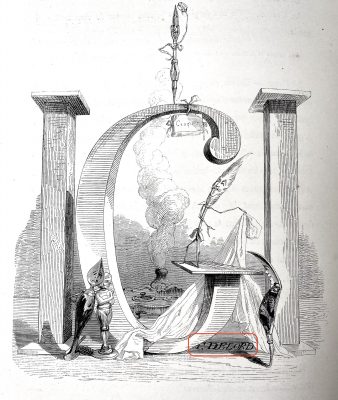
-
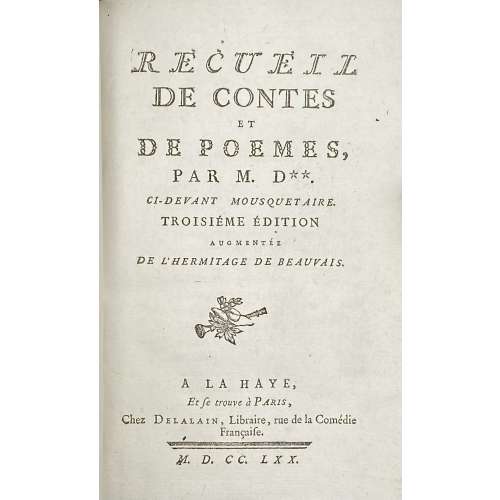 Title page: RECUEIL | DE CONTES | ET | DE POEMES, | PAR M. D**. | CI-DEVANT MOUSQUETAIRE. | TROSIÉME ÉDITION | AUGUMENTÉE | DE L'HERMITAGE DE BEAUVAIS. | [device] | A LA HAYE, | Et se trouve à Paris, | Chez Delalain, Libraire, rue de la Comédie | Française. | — | M. D. CC. LXX. IRZA | ET MARSIS , | POËME, includes: L'isle merveilleuse, Poëme, Chant 1re et Chant 2nd, Invocation a La Fontaine, and Alphonse, Conte – Cohen and De Ricci (#317) describe 2nd edition by the same publisher, 1769, 77 p., with similar illustrations after Charles Eisen: (1) engraved title by Louis Claude Legrand (2) L’Isle 1er: Frontispiece by Joseph de Longueil, (3) headpiece and (4) tailpiece by Emmanuel de Ghendt, and (5) L’Isle 2nd: Frontispiece by Jean Massard, (6) headpiece by Emmanuel de Ghendt + (7) tailpiece unsigned. Les Cerises et la Méprise, Contes en vers – Cohen and De Ricci (#311) also describe the 2nd edition of 1769, with the same (8) frontispiece by De Longueil after Eisen. Sélim et Sélima, Poeme imité de l'allemand; L'hermitage de beauvais, Conte –Cohen and De Ricci (#322) describe edition of 1769 by Sébastien Jorry, with the same (9) frontispiece by Emmanuel de Ghendt after Eisen. Size: 18.6 x 12.3 cm, small 8vo. Binding: polished, multi-coloured stained calf with gilt triple fillet border to boards; gilt floral arabesque and gilt lettering to flat spine: "Oeuvres de Dorat | Contes"; all edges gilt; blue-and-white marbled endpapers. Pagination: ffl, [2] IRZA ET MARSIS engraved half-title / blank, [1-2] - RECUEIL title page / blank, 3-8 (avis sur cette édition); [1 - L'Isle...] 2-184, bfl; Illustrations (copperplate engravings): 5 plates, 2 headpieces and 2 tailpieces. Collation: Octavo; a8 (title and avis sur cette édition); A-L8, M4. Author of the text: Claude Joseph Dorat, (French, 1734 – 1780) Artist: Charles-Dominique-JosephEisen (French, 1720 – 1778) Engravers: Emmanuel Jean Nepomucène de Ghendt (French, 1738 – 1815) Louis Claude Legrand (French, 1723 – 1807) Joseph de Longueil (French, 1730 – 1792) Jean Massard (French, 1740 – 1822)
Title page: RECUEIL | DE CONTES | ET | DE POEMES, | PAR M. D**. | CI-DEVANT MOUSQUETAIRE. | TROSIÉME ÉDITION | AUGUMENTÉE | DE L'HERMITAGE DE BEAUVAIS. | [device] | A LA HAYE, | Et se trouve à Paris, | Chez Delalain, Libraire, rue de la Comédie | Française. | — | M. D. CC. LXX. IRZA | ET MARSIS , | POËME, includes: L'isle merveilleuse, Poëme, Chant 1re et Chant 2nd, Invocation a La Fontaine, and Alphonse, Conte – Cohen and De Ricci (#317) describe 2nd edition by the same publisher, 1769, 77 p., with similar illustrations after Charles Eisen: (1) engraved title by Louis Claude Legrand (2) L’Isle 1er: Frontispiece by Joseph de Longueil, (3) headpiece and (4) tailpiece by Emmanuel de Ghendt, and (5) L’Isle 2nd: Frontispiece by Jean Massard, (6) headpiece by Emmanuel de Ghendt + (7) tailpiece unsigned. Les Cerises et la Méprise, Contes en vers – Cohen and De Ricci (#311) also describe the 2nd edition of 1769, with the same (8) frontispiece by De Longueil after Eisen. Sélim et Sélima, Poeme imité de l'allemand; L'hermitage de beauvais, Conte –Cohen and De Ricci (#322) describe edition of 1769 by Sébastien Jorry, with the same (9) frontispiece by Emmanuel de Ghendt after Eisen. Size: 18.6 x 12.3 cm, small 8vo. Binding: polished, multi-coloured stained calf with gilt triple fillet border to boards; gilt floral arabesque and gilt lettering to flat spine: "Oeuvres de Dorat | Contes"; all edges gilt; blue-and-white marbled endpapers. Pagination: ffl, [2] IRZA ET MARSIS engraved half-title / blank, [1-2] - RECUEIL title page / blank, 3-8 (avis sur cette édition); [1 - L'Isle...] 2-184, bfl; Illustrations (copperplate engravings): 5 plates, 2 headpieces and 2 tailpieces. Collation: Octavo; a8 (title and avis sur cette édition); A-L8, M4. Author of the text: Claude Joseph Dorat, (French, 1734 – 1780) Artist: Charles-Dominique-JosephEisen (French, 1720 – 1778) Engravers: Emmanuel Jean Nepomucène de Ghendt (French, 1738 – 1815) Louis Claude Legrand (French, 1723 – 1807) Joseph de Longueil (French, 1730 – 1792) Jean Massard (French, 1740 – 1822)


